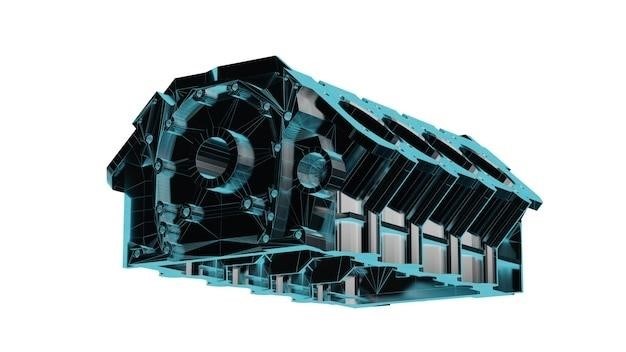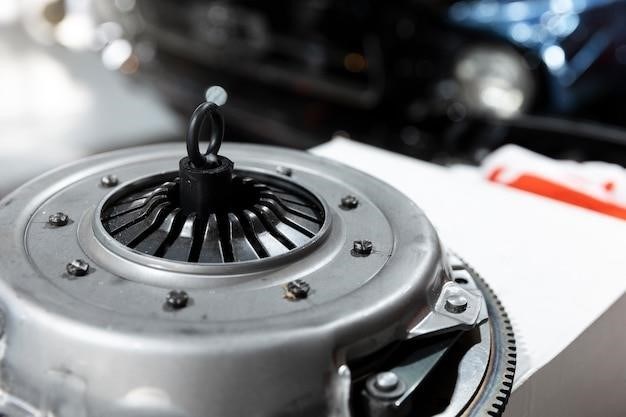Transmission Coolers for Manual Transmissions⁚ A Comprehensive Guide
Manual transmissions, unlike their automatic counterparts, typically do not require dedicated transmission coolers․ This is because manual transmissions generate less heat due to the absence of a torque converter, a primary source of heat in automatic transmissions․ However, there are exceptions, particularly in heavy-duty applications where manual transmissions and differentials might need cooling․ In these cases, a pump would be necessary to facilitate the use of a transmission cooler with a manual transmission․ Nonetheless, these scenarios are not the norm, and very few auto manufacturers opt to use transmission coolers for their manual transmissions․
Introduction
In the realm of automotive engineering, the importance of maintaining optimal operating temperatures for vital components cannot be overstated․ While automatic transmissions are well-known for their reliance on dedicated cooling systems, the question of whether manual transmissions require similar attention often arises․ The answer, while seemingly straightforward, reveals a nuanced understanding of the heat generation processes within different transmission types․
Manual transmissions, unlike their automatic counterparts, typically do not require dedicated transmission coolers․ This is because manual transmissions generate less heat due to the absence of a torque converter, a primary source of heat in automatic transmissions․ The torque converter, a fluid coupling that allows for smooth power transfer in automatic transmissions, inherently generates significant heat during operation․ Manual transmissions, relying on direct mechanical engagement between gears, produce considerably less heat․
However, the simplicity of this explanation does not encompass all scenarios․ In heavy-duty applications, where manual transmissions are subjected to prolonged periods of high load and demanding conditions, the need for cooling can arise․ Towing heavy trailers, traversing mountainous terrain, or operating in extreme ambient temperatures can push the limits of a manual transmission’s inherent heat dissipation capabilities․ In such cases, a dedicated transmission cooler can prove beneficial in preventing excessive heat buildup and ensuring the longevity of the transmission․
The inclusion of a transmission cooler for a manual transmission typically necessitates a pump to facilitate the circulation of transmission fluid through the cooler․ This system is analogous to the cooling systems found in automatic transmissions, where a pump circulates fluid through a radiator-like cooler to dissipate heat․
While the use of transmission coolers for manual transmissions remains less common compared to their automatic counterparts, it is a consideration that should be explored in situations where the transmission is subjected to significant heat loads․ The potential benefits, such as extended transmission lifespan and improved performance, can outweigh the added complexity and cost in certain demanding applications․
Why Manual Transmissions Need Cooling
While manual transmissions are generally known for their inherent simplicity and lower heat generation compared to automatic transmissions, there are specific scenarios where cooling becomes crucial for their optimal performance and longevity․ The primary reason for needing cooling in manual transmissions stems from the increased heat generated under demanding conditions, particularly in heavy-duty applications․
Heavy-duty trucks, for instance, often encounter demanding situations, such as towing trailers, navigating mountainous terrain, or operating in extreme ambient temperatures․ These conditions can significantly raise the internal temperature of the transmission, exceeding its normal operating range․ Prolonged exposure to excessive heat can lead to several detrimental effects on the transmission, including⁚
- Fluid Degradation⁚ Transmission fluid, the lifeblood of the transmission, can break down under extreme heat, losing its lubricating properties and viscosity․ This can lead to increased friction, wear, and ultimately, transmission failure․
- Component Wear⁚ High temperatures can accelerate wear on transmission components, such as gears, bearings, and seals․ This can lead to premature failure and costly repairs․
- Reduced Performance⁚ Excessive heat can affect the transmission’s efficiency, leading to sluggish shifting and reduced power output․
In situations where manual transmissions are subjected to such demanding conditions, a dedicated transmission cooler can play a vital role in mitigating these risks․ By providing an external cooling system, the cooler helps maintain the transmission fluid within its optimal operating temperature range, preventing heat-related damage and ensuring smooth, reliable performance․
In essence, while manual transmissions generally do not require dedicated cooling systems, in specific demanding applications, a transmission cooler can be a valuable investment, extending the lifespan of the transmission and preventing costly repairs․
Types of Transmission Coolers
Transmission coolers are designed to dissipate heat from the transmission fluid, maintaining optimal operating temperatures․ While the need for transmission coolers is less common in manual transmissions compared to automatic transmissions, there are various types available for those applications where cooling is required․ Here’s a breakdown of the most common types⁚

- Tube and Fin Coolers⁚ These coolers are the most basic and affordable type․ They consist of a series of tubes through which the transmission fluid flows, surrounded by fins that dissipate heat into the surrounding air․ Tube and fin coolers are simple to install and typically effective in moderate conditions․ However, their cooling capacity may be limited in demanding situations․
- Plate and Fin Coolers⁚ This type offers improved cooling efficiency compared to tube and fin coolers․ They feature a series of plates with fins that provide a larger surface area for heat dissipation․ Plate and fin coolers are more compact than tube and fin coolers and often preferred for their increased cooling capacity․
- Stacked Plate Coolers⁚ These are the most efficient and powerful type of transmission cooler․ They consist of multiple plates stacked together, creating a very large surface area for heat transfer․ Stacked plate coolers are typically used in heavy-duty applications where maximum cooling performance is required․ While they offer superior cooling, they are also the most expensive option․
The choice of transmission cooler type depends on the specific needs of the application․ Factors to consider include the vehicle’s GVWR, towing capacity, operating conditions, and the desired level of cooling performance․ For heavy-duty trucks or vehicles subjected to demanding conditions, a stacked plate cooler is often the preferred choice․ For less demanding applications, a tube and fin or plate and fin cooler may suffice․
It’s important to consult with a qualified mechanic or transmission specialist to determine the appropriate type of transmission cooler for your specific vehicle and needs․
Factors to Consider When Choosing a Transmission Cooler
While manual transmissions generally don’t require dedicated transmission coolers, there are scenarios where they become necessary, especially in heavy-duty applications․ If you’re considering a transmission cooler for your manual transmission, several factors should guide your decision⁚
- Gross Vehicle Weight Rating (GVWR)⁚ The GVWR represents the maximum operational weight of a vehicle, including the vehicle itself, passengers, cargo, and any additional equipment․ A vehicle operating close to its GVWR is likely to generate more heat, making a transmission cooler crucial․ Heavier vehicles and those used for towing often require larger coolers to handle the increased heat load․
- Towing Capacity⁚ Vehicles frequently used for towing, especially heavy trailers, experience significant heat buildup in the transmission․ Choosing a transmission cooler with a GVWR rating that exceeds the combined weight of the vehicle and the trailer is essential for effective cooling․
- Operating Conditions⁚ Factors like frequent stop-and-go driving, hilly terrain, and hot climates contribute to increased transmission temperatures․ If your vehicle operates in such conditions, a transmission cooler is recommended․ Consider a cooler with a larger capacity or higher cooling efficiency to handle the increased heat load․
- Transmission Type⁚ While manual transmissions generally generate less heat than automatic transmissions, some manual transmissions, particularly those found in heavy-duty trucks, might require cooling․ Consult your vehicle’s owner’s manual or a qualified mechanic to determine if your specific transmission needs a cooler․
- Cooler Size⁚ Transmission coolers come in various sizes, and the appropriate size depends on the vehicle’s GVWR and operating conditions․ A larger cooler provides greater cooling capacity, but it might be more challenging to install․ Consider the available space in your vehicle and the desired level of cooling performance when selecting a cooler size․
Choosing the right transmission cooler ensures optimal transmission performance and longevity․ It’s crucial to consult with a qualified mechanic or transmission specialist for guidance on selecting the appropriate cooler for your specific vehicle and needs․
Installation and Maintenance
Installing a transmission cooler on a manual transmission requires careful consideration and professional expertise․ The installation process involves integrating the cooler into the transmission fluid flow path, ensuring proper fluid circulation and heat dissipation․

Here are key steps involved in installing a transmission cooler on a manual transmission⁚
- Identifying Fluid Lines⁚ Locate the transmission fluid lines, typically found near the transmission itself․ You’ll need to identify the return line, which carries the heated fluid back to the transmission․
- Connecting the Cooler⁚ Cut the return line and insert fittings to connect the cooler’s inlet and outlet ports․ Ensure a secure connection to prevent leaks․
- Routing Lines⁚ Route the fluid lines from the transmission to the cooler and back, ensuring proper flow and avoiding any potential obstructions or pinch points․
- Securing the Cooler⁚ Mount the cooler securely to the vehicle’s frame or radiator, ensuring proper airflow for optimal heat dissipation․
- Flushing and Filling⁚ After installation, flush the transmission system to remove any air bubbles and fill the system with fresh transmission fluid․
Proper maintenance is essential for ensuring the longevity and effectiveness of your transmission cooler․ Here are some key maintenance tips⁚
- Regular Fluid Changes⁚ Follow the recommended fluid change intervals for your specific transmission․ Dirty or contaminated transmission fluid can reduce cooling efficiency and damage the cooler․
- Inspect for Leaks⁚ Periodically check for leaks around the cooler and its connections․ Leaks can lead to fluid loss and reduced cooling performance․
- Clean the Cooler⁚ Occasionally clean the cooler’s fins to remove dirt and debris that can hinder airflow and reduce cooling effectiveness․
- Inspect for Damage⁚ Visually inspect the cooler for any signs of damage, such as dents or cracks, which can compromise its integrity and cooling capacity․
Following these installation and maintenance guidelines will ensure your transmission cooler functions optimally, protecting your manual transmission from overheating and prolonging its lifespan․
Benefits of Using a Transmission Cooler
While manual transmissions generally don’t require transmission coolers, there are situations where installing a cooler can offer significant benefits, particularly in heavy-duty applications or when the transmission is subjected to high loads or extreme temperatures․ Here are some key advantages of using a transmission cooler for a manual transmission⁚
- Reduced Transmission Heat⁚ Transmission coolers effectively dissipate heat from the transmission fluid, preventing excessive temperature buildup․ This is crucial for heavy-duty applications like towing or hauling, where the transmission is under constant stress․
- Improved Transmission Longevity⁚ By keeping transmission fluid temperatures within optimal ranges, a cooler can significantly extend the life of the transmission․ Overheating can lead to premature wear and tear on internal components, ultimately shortening the transmission’s lifespan․
- Enhanced Performance⁚ Cool transmission fluid allows for more efficient gear changes and smoother operation․ This can improve overall drivability, particularly in demanding conditions․
- Improved Fuel Efficiency⁚ A cooler transmission operates more efficiently, reducing energy loss due to heat․ This can contribute to better fuel economy, especially when towing or driving in hot climates․
- Safety Enhancement⁚ In extreme cases, a transmission cooler can help prevent catastrophic failure, such as a transmission meltdown․ This is especially important in heavy-duty applications where a transmission failure could result in costly repairs or even a safety hazard․
Although a transmission cooler is not typically a standard feature on manual transmissions, its benefits can be significant in certain scenarios, particularly where the transmission is subjected to high stress or extreme operating conditions․ By investing in a properly installed and maintained transmission cooler, you can enhance the longevity, performance, and safety of your manual transmission․
